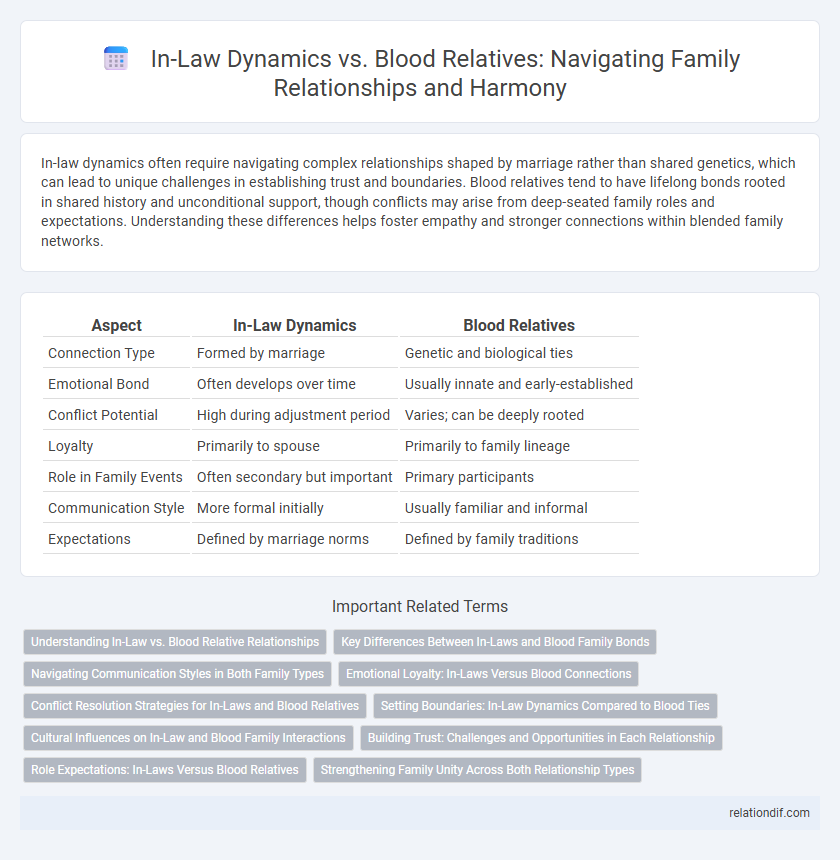In-law dynamics often require navigating complex relationships shaped by marriage rather than shared genetics, which can lead to unique challenges in establishing trust and boundaries. Blood relatives tend to have lifelong bonds rooted in shared history and unconditional support, though conflicts may arise from deep-seated family roles and expectations. Understanding these differences helps foster empathy and stronger connections within blended family networks.
Table of Comparison
| Aspect | In-Law Dynamics | Blood Relatives |
|---|---|---|
| Connection Type | Formed by marriage | Genetic and biological ties |
| Emotional Bond | Often develops over time | Usually innate and early-established |
| Conflict Potential | High during adjustment period | Varies; can be deeply rooted |
| Loyalty | Primarily to spouse | Primarily to family lineage |
| Role in Family Events | Often secondary but important | Primary participants |
| Communication Style | More formal initially | Usually familiar and informal |
| Expectations | Defined by marriage norms | Defined by family traditions |
Understanding In-Law vs. Blood Relative Relationships
Understanding in-law versus blood relative relationships requires recognizing differences in emotional bonds and shared history; blood relatives often share genetic connections and a lifelong background, while in-laws are linked through marriage, creating new family dynamics. In-law relationships can involve navigating boundaries, expectations, and roles that differ from those with blood relatives, making communication and mutual respect crucial. Positive in-law interactions contribute to family harmony and support networks, influencing overall familial cohesion.
Key Differences Between In-Laws and Blood Family Bonds
In-law relationships often involve chosen social bonds that require negotiation and mutual respect, whereas blood family bonds are typically based on biological connections with an inherent sense of obligation and shared history. Emotional intimacy and loyalty dynamics differ, as in-laws may develop affection through shared experiences rather than genetic ties. Conflict resolution approaches and expectations of support also vary, with blood relatives often assuming more automatic roles in caregiving and inheritance.
Navigating Communication Styles in Both Family Types
Navigating communication styles within in-law dynamics requires understanding cultural nuances, expectations, and boundaries distinct from those typical with blood relatives. Effective communication often hinges on balancing respect and assertiveness to foster trust and prevent misunderstandings in blended families. Adapting to these diverse interpersonal approaches enhances harmony and strengthens family cohesion over time.
Emotional Loyalty: In-Laws Versus Blood Connections
Emotional loyalty often varies between in-laws and blood relatives, with blood connections typically fostering a deep-rooted sense of shared history and unconditional support. In-laws may experience fluctuating loyalty influenced by marital bonds and evolving family roles, requiring conscious effort to build trust and emotional closeness. Navigating these dynamics successfully depends on open communication and mutual respect, enhancing family cohesion across relational boundaries.
Conflict Resolution Strategies for In-Laws and Blood Relatives
Effective conflict resolution strategies for in-laws and blood relatives hinge on clear communication, empathy, and setting healthy boundaries to prevent misunderstandings and resentment. Utilizing active listening techniques and seeking common ground fosters mutual respect and reduces tension, while mediation or counseling can be beneficial in deeply entrenched conflicts. Prioritizing family harmony through consistent effort and understanding cultural differences within familial roles enhances long-term relationship stability.
Setting Boundaries: In-Law Dynamics Compared to Blood Ties
Setting boundaries with in-laws often requires more explicit communication and negotiation than with blood relatives due to differing expectations and less established familial roles. While blood relatives typically share a foundational understanding and long-term history, in-laws may necessitate clearer limits to maintain respect and harmony within the extended family. Recognizing these distinctions helps foster healthy relationships by balancing closeness with necessary space.
Cultural Influences on In-Law and Blood Family Interactions
Cultural norms and traditions significantly shape interactions between in-laws and blood relatives, often dictating roles, expectations, and communication patterns within families. In collectivist cultures, in-law relationships tend to emphasize hierarchical respect and communal decision-making, highlighting obligations that may surpass those towards blood relatives. Western individualistic societies, in contrast, often prioritize nuclear family autonomy, resulting in more flexible and less formal interactions with both in-laws and blood kin.
Building Trust: Challenges and Opportunities in Each Relationship
In-law dynamics often require deliberate efforts to build trust due to differing family cultures and initial outsider status, whereas trust with blood relatives usually develops naturally over time from shared experiences. Challenges in in-law relationships include overcoming preconceived notions and establishing mutual respect, while opportunities arise from creating new family bonds through empathy and open communication. Blood relatives can face trust issues stemming from historical conflicts, but these can be resolved through consistent reliability and transparent dialogue, fostering deeper familial connections.
Role Expectations: In-Laws Versus Blood Relatives
Role expectations in family dynamics often differ significantly between in-laws and blood relatives, as in-laws are typically anticipated to respect established boundaries and support the couple's decisions without direct intervention. Blood relatives usually have deeper emotional ties and historical context, leading to more intricate expectations around loyalty, caregiving, and involvement in personal matters. Understanding these differences helps navigate potential conflicts and fosters healthier family relationships by setting clear and appropriate boundaries for each group.
Strengthening Family Unity Across Both Relationship Types
Navigating in-law dynamics alongside blood relative relationships requires open communication and mutual respect to build trust and cohesion. Emphasizing shared values and collaborative problem-solving fosters a strong family foundation that bridges both types of connections. Prioritizing empathy and inclusive traditions enhances family unity, creating a supportive environment for all members.
in-law dynamics vs blood relatives Infographic

 relationdif.com
relationdif.com